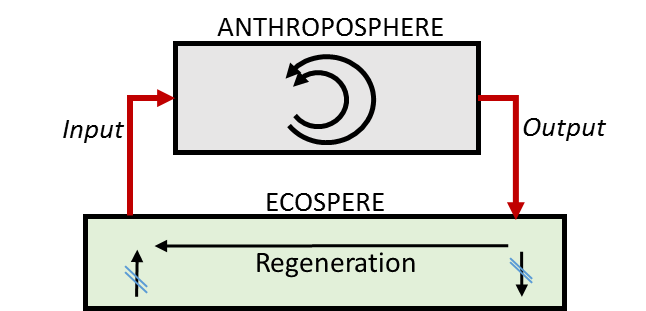Have you been thinking of ”circular economy” indicators lately? A lot of us have, and we think the industrial ecology community has an important role to play in this debate. Today, the suggestions for monitoring a circular economy are scattered and the objectives go apart. Given the environmental ambitions of EU Circular Economy Policy, we looked at how “circular economy” indicators capture environmental flows between the anthroposphere and the ecosphere. We found that only a few of them capture the environmental flows. Indicators claiming to address the circular economy often solely address specific parts of what circularity entails, such as recycling. With over 100 definitions of the “circular economy”, we don’t seem to agree on what this concept means. This is what we think is important for the monitoring of a “circular economy”.
The conceptual understanding of circular economy that we applied for assessing circular economy indicators was based on the socio-economic metabolism. In short, we assumed that circular economy strategies will help to circulate resources and prolong resource use within the anthroposphere, thus, it will decrease input and output flows and in turn release environmental burden.
 |
|
The conceptual understanding of circular economy in the socio-economic metabolism. |
By selecting only indicators that state “circular economy” as one of their main applications, we aimed to get a somewhat representative selection for what is understood under this concept. Not surprisingly, the indicators were scattered. Out of ten, three indicators focused mainly on production, one on the use phase, four on end-of-life and two covered several life-cycle stages. Four indicators where given in monetized terms, four in mass, and the remaining two used exergy and time. Particularly interesting is the naming of the indicators: the results present diverse uses of the term “circular economy”. For instance, the ”circular economy performance indicator” addresses waste treatment of plastic and the ”circular economy index” measures the recycling rate but in monetary terms. Other suggestions include assessing the circular economy through the reuse potential of a waste flow. Product-level circularity is measured as the share of recycled parts in economic terms.
Our conclusion was that, despite the conceptual link between the circular economy strategies and environmental pressures, mass balances could in most cases not support an interconnection between the suggested measurements and the environmental flows. The probabilities for rebound effects and burden shifting are high. Therefore, established environmental indicators such as footprint accounting seem to better serve the circular economy in regards to its environmental pressure. To ensure that a circular economy contributes to decreased environmental pressures, footprint accounting or similar environmental indicators are crucial and should not be replaced, but complemented, with more specific process-oriented indicators.
Today, the EU provides a monitoring framework to assess the progress towards circularity. The framework emphasises end-of-life management, competitiveness and innovation. Given the clear overlap between the circular economy and industrial ecology, we think that this community can push policy makers to include indicators measuring key environmental and resource flows. We can do this by increasingly working on an agreed monitoring framework. We believe this is necessary to support a transition towards a more sustainable circular economy. In recent months, a number of publications have dealt with circular economy indicators and contributed to this body of research from different perspectives. Hence, joint efforts would be highly valuable to inform policy and practice.
This post was contributed by Hanna Helander and Anna Petit-Boix. It is based on their original research published here in the JIE.